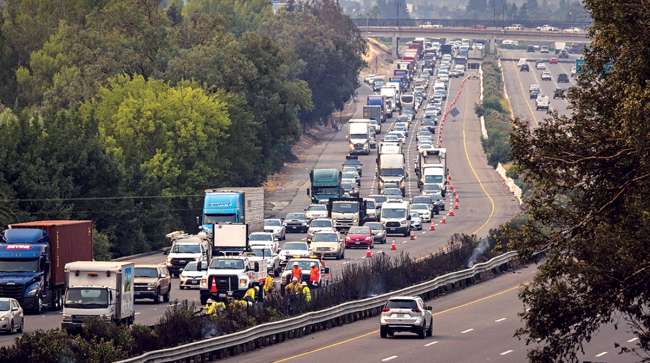Staff Reporter
Freight Economy Among Priorities of California’s Long-Term Plan

[Stay on top of transportation news: Get TTNews in your inbox.]
Improving freight movement in support of a strong economy is one of the priorities listed in the California Department of Transportation’s long-range transportation plan.
The department’s California Transportation Plan 2050 establishes a policy framework for the future of the transportation system, with goals of improving mobility and reducing greenhouse gas emissions over the next three decades.
“California’s transportation system connects 40 million residents to jobs, housing, vital services and recreation,” said Caltrans Director Toks Omishakin. “The plan sets a bold vision to foster economic vitality, protect our environment and meet the transportation needs of all Californians.”
The plan lists expanding economic opportunities through the efficient movement of freight, services and people as a key objective over the coming decades. Another objective is to enhance the safety of the bridges and roads that trucks and passenger vehicles travel on. The plan notes truck parking availability, weigh-in-motion stations and alternative fueling locations are critical for a healthy freight infrastructure system. Trucks are the primary mode of transportation for freight in California, hauling 3.8 million tons per day.

Omishakin
In the near term, spurring economic growth and expanding transit services are meant to help the state recover from the impacts of the COVID-19 pandemic. The plan states the outbreak of COVID-19 in early 2020 drove California’s unemployment rate to 25%.
Reducing the negative environmental impacts of the transportation sector is another priority noted in the plan. Caltrans has a goal of reducing transportation-related greenhouse gas emissions to 80% below 1990 emissions levels by 2050. Heavy-duty trucks, ships, airplanes and trains account for about three-quarters of the oxides of nitrogen emitted in California.
Caltrans’ suggestions include expanding low-carbon mobility options and promoting the use of pedestrian and bicycle paths. Other potential solutions include teleworking and attending doctor visits virtually, practices that have become common during the pandemic.
Today, Caltrans unveiled the California Transportation Plan 2050, our overarching roadmap toward a safer, more innovative and sustainable transportation system for all users. Check out the #CTP2050 at https://t.co/WauHMcfDop pic.twitter.com/7vamKHUizf — Caltrans HQ (@CaltransHQ) March 3, 2021
The plan suggests roadway pricing, such as tolling or congestion pricing, as a way to reduce emissions and improve the efficiency of travel. Caltrans’ priorities for roadway pricing include ensuring the system is equitable, investing the revenue into alternative transportation options and considering the impacts on freight and delivery drivers.
“Increasing the cost of goods movement can increase the cost for consumers, and truck freight carriers typically do not have feasible alternatives,” according to the plan.
The Los Angeles County Metropolitan Transportation Authority is currently conducting a two-year Traffic Reduction Study, which considers managing traffic through congestion pricing. Los Angeles is home to some of the worst traffic congestion in the country. The city is listed four times on the American Transportation Research Institute’s top truck bottlenecks report, which was released in February.

Fleets are investing in tech-based safety tools that inform and forewarn potential risk. But how do they condition and prepare drivers to respond to safety alerts? Find out as the RoadSigns Team speaks with Tom DiSalvi, VP of safety at Schneider National, and Charlie Mohn, director of product innovation at Drivewyze. Hear a snippet, above, and get the full program by going to RoadSigns.TTNews.com.
During Caltrans’ development of the plan, roadway congestion was initially reduced in many cities due to the pandemic. However, Caltrans indicated vehicle travel has returned to nearly pre-pandemic levels. Beyond that, the agency suggested vehicle travel is expected to worsen, especially if transit ridership remains below pre-pandemic levels.
As a way to advance economic and racial justice, Caltrans aims to direct resources to underinvested areas and engage with members of the public.
Caltrans anticipates the state’s transportation system will need to support an estimated 45 million residents by 2050. Also by 2050, truck trips are expected to increase by 40% as the state’s demand for goods grows with its increasing population.
Want more news? Listen to today's daily briefing below or go here for more info:




